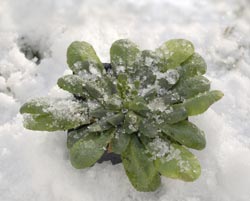Plants point the way to coping with climate change

Plant in Snow
The importance of the discovery is that it reveals how a species has developed different responses to different climates in a short period of time.
Researchers at the John Innes Centre (JIC) have been examining how plants use the cold of winter to time their flowering for the relative warmth of spring. This process, called vernalization, varies even within the same plant species, depending on local climate. In Scandinavia, where winter temperatures can vary widely, the model plant, Arabidopsis has a slow vernalization response to prevent plants from being 'fooled' into flowering by a short mid-winter thaw.
One particular gene, named FLC, delays flowering over the winter and the research team discovered how cold turns off FLC and what keeps it off during growth in spring. In the UK plants only need four weeks of cold to stably inactivate FLC, allowing plants to start their spring flowering early. Arabidopsis plants in Sweden have a mechanism that requires 14 straight weeks of winter cold before FLC is stably inactivated. This prevents the plants flowering only to be hit with another month of harsh winter weather.
Research leader at JIC, Professor Caroline Dean, explains: “We studied levels of the FLC gene in Arabidopsis plants from different parts of the world expecting to find regional variations that correlated with how much cold was required to switch FLC off. We discovered that FLC levels in autumn and the rate of reduction during the early phases of cold were quite similar in Arabidopsis plants from Edinburgh and N. Scandinavia . However, we found big variations in how much cold was required to achieve stable inactivation of FLC. FLC was stably silenced much faster in Edinburgh than it was in N. Scandinavia and a genetic analysis showed that differences in the FLC gene itself contributed to this variation.
Professor Dean said: “It looks like the variation in this mechanism to adapt the timing of flowering to different winter conditions has evolved extremely quickly. We hope that by understanding how plants have adapted to different climates it will give us a head-start in breeding crops able to cope with global warming.”
The JIC scientists worked in collaboration with a team at the University of Southern California and were funded by the UK's main public funders of biological and environmental sciences, the Biotechnology and Biological Sciences Research Council (BBSRC) and the Natural Environment Research Council.
Professor Julia Goodfellow, BBSRC Chief Executive, commented: “As well as working to prevent climate change we need to be able to harness natural methods to adapt food crops to cope with changed and hostile climates around the world. This is an example of how basic science can make a practical difference.”
Media Contact
More Information:
http://www.bbsrc.ac.ukAll latest news from the category: Ecology, The Environment and Conservation
This complex theme deals primarily with interactions between organisms and the environmental factors that impact them, but to a greater extent between individual inanimate environmental factors.
innovations-report offers informative reports and articles on topics such as climate protection, landscape conservation, ecological systems, wildlife and nature parks and ecosystem efficiency and balance.
Newest articles

Properties of new materials for microchips
… can now be measured well. Reseachers of Delft University of Technology demonstrated measuring performance properties of ultrathin silicon membranes. Making ever smaller and more powerful chips requires new ultrathin…

Floating solar’s potential
… to support sustainable development by addressing climate, water, and energy goals holistically. A new study published this week in Nature Energy raises the potential for floating solar photovoltaics (FPV)…

Skyrmions move at record speeds
… a step towards the computing of the future. An international research team led by scientists from the CNRS1 has discovered that the magnetic nanobubbles2 known as skyrmions can be…





















